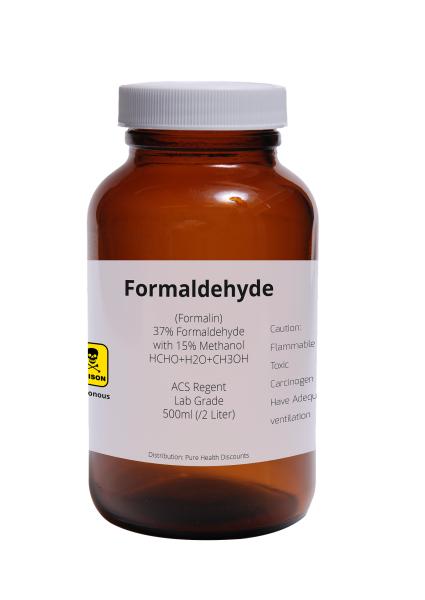Background on Formaldehyde
Many people became aware of formaldehyde after Hurricane Katrina, where it made the news after being detected in the FEMA trailers provided to house the hurricane victims. Formaldehyde was detected because it is used in building materials, insulation, carpets, and the manufacture of composite wood products. It is also found in household products such as glues, paints, cleaning products, and consumer products such as medicines and cosmetics. At very high levels, formaldehyde causes respiratory effects, from nose and throat irritation to asthma-related conditions.
However, most people are unaware that formaldehyde is also produced by the human body and is required for cell growth in all living cells. As discussed by ACSH’s Dr. Josh Bloom, formaldehyde is produced by the body in a biochemical pathway called the one-carbon cycle. Formaldehyde is detoxified within the body to non-toxic formate, which the body uses to create DNA and essential amino acids. The European Food Safety Agency estimates that the human body makes and processes a very large amount, about 50 grams or four tablespoons of formaldehyde every day.
What is IRIS and an IRIS Toxicological Review Document?
IRIS is EPA’s database designed to provide a summary of the EPA’s health information to be used across EPA, so everyone within the Agency was using the same data. These data have no regulatory authority by themselves but are the basis for EPA regulations. For example, when the Office of Water writes a regulation for a chemical in drinking water, they look to IRIS to provide the numerical data that serves as the basis for the regulation. They then factor in statutorily mandated requirements from the Safe Drinking Water Act, such as cost, available treatment technologies, and analytical methods.
The data within IRIS are developed based on the available scientific data. A summary of the available data, human epidemiological studies, animal studies, and mechanistic studies done in cells and the basis and calculations within these studies are provided in the IRIS Toxicological Review Document.
The Formaldehyde IRIS Document
I have scientific and procedural concerns with this report. Let’s begin with the scientific Issues involving the section related to the association of formaldehyde with cancers.
“[There is] evidence that formaldehyde inhalation causes nasopharyngeal cancer, sinonasal cancer, and myeloid leukemia in exposed humans given appropriate exposure circumstances.” [emphasis added]
I searched the entire IRIS document and could not find EPA’s definition of what “the appropriate exposure circumstances” are for formaldehyde to cause cancer.
The EPA considered there to be “robust evidence in humans and animals” of an association between formaldehyde and nasopharyngeal cancer. (Nasopharyngeal cancer involves the nose and throat.) The EPA based its quantitative estimate of carcinogenic risk from inhalation exposure on the largest and best study done on US workers in the formaldehyde industries: the National Cancer Institute’s cohort of 25,000 workers followed for over 40 years. This study meets all the standards for a good quality epidemiological study – a large population studied for an extended period - more than sufficient for cancer development to be observed.
The study reported only 10 cases of nasopharyngeal cancer. This statistically significant result was observed only at the highest exposure doses, > 4 parts per million. It was considered significant enough to be the basis for EPA’s concern.
Nasopharyngeal cancer is a rare cancer in the US; less than one person out of 100,000 people is diagnosed with nasopharyngeal cancer per year in the U.S.
For context, our homes are the most significant source of formaldehyde exposure for those not working with formaldehyde. According to California’s EPA, there are 20 parts per billion in conventional homes and 40 parts per billion in manufactured homes. Smoking results in formaldehyde levels of 2.3 to 6.1 parts per million. While this cohort’s exposure to formaldehyde was painstakingly described, there was no adjustment for their smoking history. Bear in mind that the participants were employed between 1934 and 1958, when 40% of the American population smoked. The carefully constructed formaldehyde doses are more uncertain without adjustment or consideration for formaldehyde exposure from smoking.
With only 10 cases of cancer found in the best human study available, one has to question EPA’s conclusion of “robust evidence” for nasopharyngeal cancer.
Sinonasal cancer is restricted to the nose and nasal cavities. Again, the EPA considered there to be “robust evidence in humans and moderate evidence in animals” of an association between formaldehyde and sinonasal cancer. But the EPA did not calculate a quantitative estimate of the carcinogenic risk due to “inadequate data.” It makes one wonder why there was inadequate data to calculate a number but sufficient data to label formaldehyde a carcinogen for sinonasal cancer.
Myeloid leukemia is a blood and bone marrow cancer, again with “robust evidence in humans and no evidence in animals.” Here, the EPA quantitative risk estimate was from the NCI cohort. But the study did NOT find an association between cumulative exposure to formaldehyde and myeloid leukemia; only a marginal association (p value of 0.1) for all leukemias and cumulative formaldehyde exposure. The EPA acknowledged that “they could not use the standard approach to calculate the quantitative risk estimate due to inadequate statistical power.” Their “innovative approach” combined myeloid leukemia with other/unspecified leukemia, even though EPA acknowledged that “these other cancer subtypes are not necessarily associated with formaldehyde exposure.”
In summary, one wonders whether there wasn’t a predetermined bias toward showing that formaldehyde caused cancer since the scientific basis for an association with all three types of cancer was anything but “robust.” In addition, the association of formaldehyde with leukemia was so weak that EPA had to use an “innovative approach” – code word for an unscientific approach, to generate health numbers for this type of cancer.
Procedural Issues
As outlined by the American Chemistry Council (ACC), an industry-based advocacy group, a review of the process for developing the IRIS formaldehyde document reveals a “troubling pattern of process irregularities, lack of independence, bias, and conflicts of interest that demonstrates a need for greater scrutiny and transparency.”
- The lead NAS staff officer was a senior EPA official from 2005 to 2014 and played a key role in reviewing a previous draft formaldehyde IRIS document from 2010. This direct involvement may have hindered the NAS staff officer’s ability to remain objective in their current role.
- EPA violated its IRIS process and policies by ambiguously prioritizing the assessment in 2021 and failing to include critical steps, such as a systematic review protocol.
- The formaldehyde assessment lacked a thorough formal interagency review process.
The Long and Tortured History of the Formaldehyde IRIS Document
In 1990 and 1991, EPA published an IRIS assessment for formaldehyde that consisted of risk information for oral exposure and a quantitative estimate of carcinogenic risk from inhalation exposure. These numbers have not been updated since that time! What has been going on at EPA concerning formaldehyde for the last 31 years?
EPA began reassessing formaldehyde in 1998 and released a draft IRIS document for formaldehyde in 2010. In 2011, the National Academy of Sciences conducted an independent scientific review of the draft IRIS document, and in 2014, EPA convened a state-of-the-science workshop on formaldehyde. In 2017, EPA completed a “new” draft IRIS document for formaldehyde that was suspended in 2018. In 2021, the IRIS document was “unsuspended” and prioritized for work in 2021, culminating in the release of the document now being discussed.
The Larger Issue
There is a problem when it has taken EPA 31 years to update the health numbers on formaldehyde, and the publication of this IRIS document is by no means the end of the story. This situation is not unique to formaldehyde; many other chemicals take 20+ years to do an IRIS assessment, with no final health assessments ever done. As I tried to highlight in the International Journal of Scientific Research in Environmental Science and Toxicology, the idea of a single database in EPA is correct. Still, the process has become unworkable – diminishing the quality of the documents and resulting in the virtual shut-down of updating information for chemicals (only 25% of the 510 chemicals have been completed since 2000). This has resulted in a lack of scientific authority for EPA because they are using outdated and incomplete scientific information in their assessments.
The Formaldehyde Document is just the latest example of a broken process. The ACC has outlined the procedural problems in developing the IRIS Toxicological Review Document for Formaldehyde. My biggest concern is the lack of scientific rigor behind the document. Good science has to be at the core of the decision-making process. It is troubling to be left with the feeling that the objective of showing that formaldehyde causes cancer drove the scientific results. This kind of outcome erodes the confidence of the scientific community and, ultimately, the public in the EPA.
Sources: Draft IRIS Toxicological Review of Formaldehyde (Inhalation)




